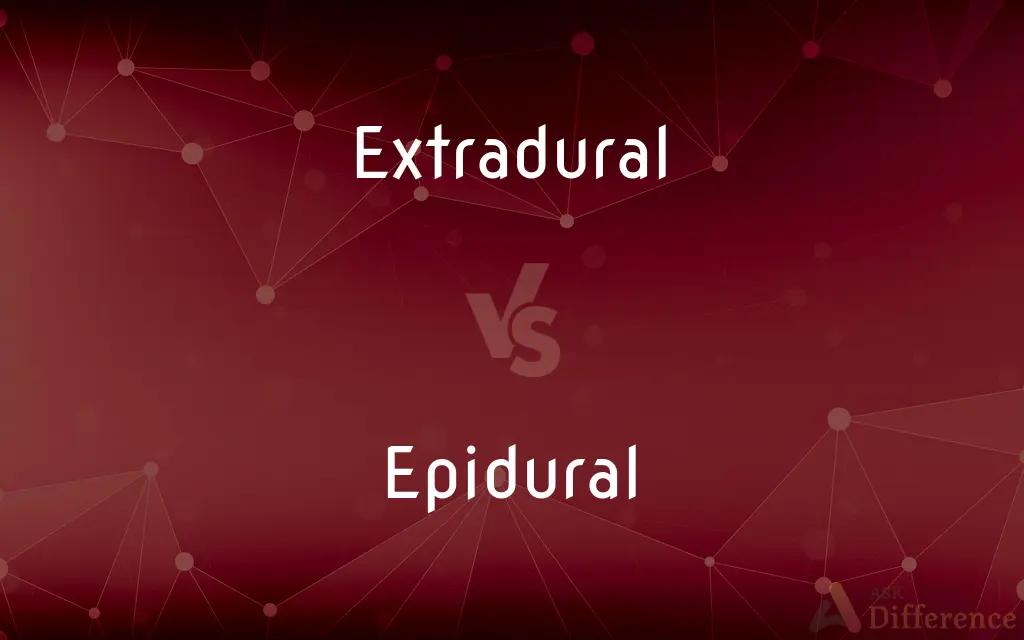Extradural vs. Epidural — What's the Difference?
By Urooj Arif & Maham Liaqat — Updated on May 3, 2024
Extradural and epidural are terms often used interchangeably to describe a space outside the dura mater, especially in medical contexts related to anesthesia.

Difference Between Extradural and Epidural
Table of Contents
ADVERTISEMENT
Key Differences
Extradural and epidural both refer to the anatomical space outside the dura mater, the tough outer membrane covering the brain and spinal cord. This space is targeted in certain medical procedures.
The term "epidural" is more commonly used, especially when referring to the types of anesthesia administered during childbirth and certain types of surgeries, where medication is injected into this space to block pain.
"Extradural" is less commonly used but is essentially synonymous with "epidural" in most contexts. However, it might sometimes be used in more clinical or detailed medical discussions to emphasize the location outside the dura mater.
In terms of application, while both terms can describe the space for administering anesthesia, "epidural" is specifically associated with the epidural block, a common procedure used to alleviate pain during labor and postoperative recovery.
Despite their interchangeability, some medical texts may prefer "extradural" to describe the location of certain pathologies like extradural hematomas, to specify that they occur outside the dura mater but still within the skull or spinal column.
ADVERTISEMENT
Comparison Chart
Terminology
Less commonly used
More commonly used, especially in anesthesia
Location
Outside the dura mater
Outside the dura mater
Usage in Medical Context
Sometimes used to describe specific pathologies or locations
Commonly used to describe anesthesia techniques
Associated Procedures
Used generally to describe location
Specifically linked with pain management procedures
Common Associations
May be used in detailed clinical discussions
Widely associated with labor and surgical anesthesia
Compare with Definitions
Extradural
Often used in neurosurgery to describe specific locations.
The extradural approach was chosen to minimize risk during the procedure.
Epidural
Commonly associated with childbirth and postoperative pain relief.
The epidural block provided significant pain relief during delivery.
Extradural
Sometimes used synonymously with epidural in specific contexts.
The medication was administered in the extradural space for pain relief.
Epidural
Frequently mentioned in patient care and hospital settings.
The nurse checked the epidural infusion pump for proper function.
Extradural
Pertaining to the space outside the dura mater.
The surgeon noted the presence of an extradural hematoma needing intervention.
Epidural
Broadly recognized by the public in the context of medical procedures.
He was familiar with the term epidural from discussions about childbirth options.
Extradural
Used in academic and detailed medical texts.
The study focused on extradural compression effects on spinal cord function.
Epidural
Refers to an injection into the space outside the dura mater, particularly for anesthesia.
She opted for an epidural to manage labor pain.
Extradural
Refers to conditions or interventions outside the dural membrane.
Extradural abscesses require immediate surgical drainage.
Epidural
Used to describe a specific type of pain management technique.
Epidural anesthesia is preferred for its effectiveness and safety.
Extradural
(anatomy) Outside of the dura mater
Epidural
Located on or over the dura mater.
Extradural
Such an injection
Epidural
An injection into the epidural space of the spine.
Extradural
On or outside the dura mater
Epidural
Situated on or outside the dura mater.
Epidural
Of or pertaining to the space immediately outside the dura mater.
Epidural anesthesia is commonly used for pain relief during childbirth.
Epidural
(medicine) An injection of anaesthetic into the epidural space of the spine, especially associated with pain relief during childbirth.
Epidural
Regional anesthesia resulting from injection of an anesthetic into the epidural space of the spinal cord; sensation is lost in the abdominal and genital and pelvic areas; used in childbirth and gynecological surgery
Epidural
On or outside the dura mater
Common Curiosities
What might a doctor look for in an extradural examination?
A doctor might assess this space for the presence of hematomas, abscesses, or other pathologies affecting the spinal cord or brain.
What are common risks associated with extradural procedures?
Common risks include bleeding, infection, and potential damage to the spinal nerves or cord.
Are extradural and epidural the same?
Yes, in most contexts, they are used interchangeably to describe the space outside the dura mater, though "epidural" is more commonly used.
What does extradural mean in medical terms?
It refers to the area located outside the dura mater, particularly in relation to the spinal cord and brain.
How safe is an epidural anesthesia?
Epidural anesthesia is generally safe when performed by experienced professionals, though it carries typical risks associated with any anesthesia, such as infection or nerve damage.
Can extradural be used to describe conditions other than hematomas?
Yes, it can also describe other conditions like abscesses or cysts that occur outside the dura mater.
Is there any difference in the procedure for extradural vs. epidural injections?
The procedure is the same as both terms refer to injections made into the space outside the dura mater.
Why is epidural more commonly used than extradural?
"Epidural" is more popular in public discourse and medical practices, especially related to anesthesia, due to its frequent use in contexts like childbirth.
What is an epidural used for?
Epidurals are primarily used for administering anesthesia during surgeries and labor to block pain in a specific region of the body.
Who might require an epidural or extradural procedure?
Patients needing pain relief for childbirth, surgery, or to manage chronic back pain might require these procedures.
What type of anesthesia is typically used in epidural injections?
Local anesthetics, sometimes combined with corticosteroids or opioids, are used to manage pain effectively.
What should patients know about post-epidural care?
Patients should monitor the injection site for signs of infection and manage any mild side effects, such as backache or headaches, under medical guidance.
How do medical professionals decide between an extradural or epidural approach?
The choice is typically based on the terminology preferred by medical professionals or the specific context, although the approach is technically the same.
Can epidural anesthesia be used during minor surgeries?
Yes, it can be used for lower body surgeries where it is beneficial to avoid deeper forms of anesthesia.
How do patients typically respond to epidural anesthesia?
Most patients respond well, experiencing significant pain reduction during procedures.
Share Your Discovery

Previous Comparison
Pastrami vs. Ham
Next Comparison
Acrylic vs. AcetateAuthor Spotlight
Written by
Urooj ArifUrooj is a skilled content writer at Ask Difference, known for her exceptional ability to simplify complex topics into engaging and informative content. With a passion for research and a flair for clear, concise writing, she consistently delivers articles that resonate with our diverse audience.
Co-written by
Maham Liaqat















































